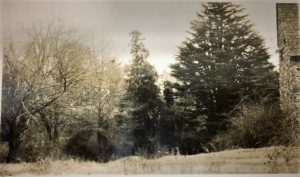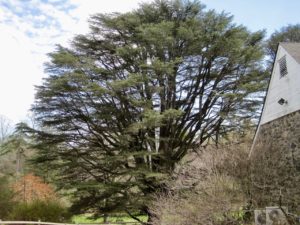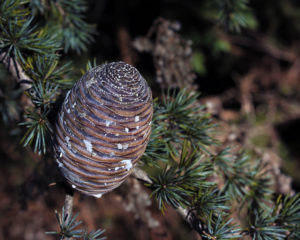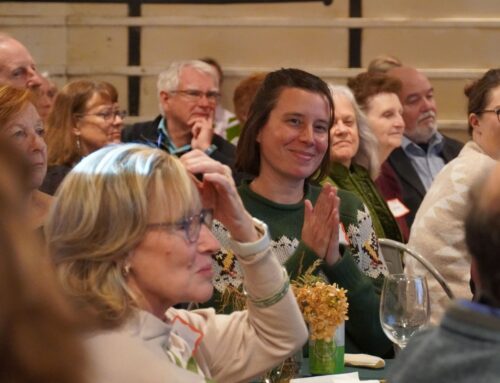Initially, I was only worth 25 cents when Minshall Painter bought me from Hoppes & Bro. Nursery in West Chester in 1859. I came home with another of my kind, and we got our first recognition in print in 1863 confirming we were planted in a section of the farm now called the Old Arboretum, not far from Minshall and Jacob Painter’s home, known as Lachford Hall. The second of my kind did not hang around as long as I have, it passed sometime after 1946.
Over the long years I have heard and seen many things. As a sapling, I overheard the Quaker brothers sharing their concern over the war as they stood outside the house on a spring evening in April of 1861. Looking out over Rocky Run, they talked about the Confederate Army attacking Fort Sumner. Just two months later, I heard their worried tone once again as they conversed regarding the additional four states that had joined the Confederacy. I heard their sorrow the night of July 3, 1863 when word spread about the 7,058 killed, 33,264 wounded and 10,790 missing after a three-day battle in Gettysburg. The brothers spoke of the tragedies of war and how it now seemed to be nearly at their doorstep. I continued to hear updates of war and slavery as they discussed with one another what they had read in the abolitionist papers to which they subscribed.
Even through the shadow of war our community grew as I did. Each year since my birth new plantings were added until there were nearly 1,000 species and varieties of trees and shrubs; about 200 varieties of fruit trees, and about 200 herbaceous plants, mostly secured from nearby botanists and horticulturists. Beneath the ground, through the fungal network in the soil, we communicated with one another about the richness of the earth and the sweetness of the sunlight. About the even rains that fell, and the storms that shook our branches.
I saw Jacob Painter leaving the property and saying goodbye to Minshall one evening, letting him know that he would be home late due to his attendance at a woman’s suffrage meeting. The fight for women’s rights went on for decades. In the early 1900’s, I began to see women with buttons that read, “Ballots for Both”. Minshall would have rejoiced with the passing of the 19th amendment in 1920 had he been alive, yet I wonder if he would have thought it a complete victory given women of color were impeded in voting due to poll taxes, literacy requirements, and citizenship. Much later, in 2020, on the centennial of women’s right to vote, I heard a conversation about women and politics as the mothers near me discussed Kamala Harris and how glad they were to see a woman voted in as the second highest leader of the land. I also heard their young daughters remind them that she is not only a woman, but also the first woman of color to become Vice-President.
I missed the daily presence of Minshall and Jacob when the two brother’s passed in 1876. Neither had married and their younger sister Ann inherited the property. Ann later turned over the management to her son John, who promptly renovated the old farmhouse beside me, changed the roofline, plastered the exterior stone walls with stucco and changed the windows to appear as a Victorian country summer home. Though the Tylers only spent their summers on the property for the next 50 years, I witnessed so much when they visited me.
As John took on management of the farm, I saw my first pair of denim jeans. From 1873 till today they have been part of the landscape at Tyler. I first saw them used as working clothes, then on teenagers. They have changed over the years, but the fabric remains the same – much like the way the farm here at Tyler has changed, but the soil has not. I still send messages through my roots. Many of the old ones have gone, though some remain, the ginkgo who is my neighbor, the old oaks across Rocky Run. The sequoia beside Painter Road. There are many new ones too, young ones who have much to learn.
I hate to brag, but I am somewhat of a celebrity. People have been taking photos of me, for nearly 150 years. Well, to be honest, I think they were having photos of themselves taken next to me. My photographs along with their portraits began in 1878. Then in 1888, I began seeing small portable easy-to-use box cameras using celluloid film designed and manufacture by George Eastman called “Kodak”. In 1936, I saw the first 35 mm SLR (single lens reflex) camera. Then, I saw people using something they called a “Polaroid” after we became a public garden in 1948. In 1975, I saw my first ever digital camera. It looked more than a bit heavy at 8 lbs. Then, in 1994, I was privileged to be in the frame of the first consumer camera to take color images under $1,000. By the end of 2003, people were not only using their mobile phones for talking, but also taking photographs with them too. These days, a day doesn’t go by in which I am not in someone’s selfie. I’ve been in wedding photos, family photos with children and grandparents. Photos of happy visits with people young and old. I imagine all those photos in albums across the country. Sometimes I pretend it is all about me.
In the years that followed, until the death of John Tyler in 1930 and his wife Laura’s passing in 1944, Tyler was a place filled with family and acquaintances. There was so much that we witnessed together. The making of the Model T Ford in 1908, in 1912 New Mexico and Arizona become states, the creation of Mother’s Day in 1914, the beginning of World War 1 in 1917, the influenza pandemic in 1918, the opening of Yankee Stadium in 1923, the Scopes Trial in 1925, and the Great Depression in 1929.
I gained a lot more company, upon Laura Hoopes Tyler’s death, when she honored the wishes of her late husband, and Tyler became an Arboretum and welcomed the public in 1944. I have scarcely had a moment to myself, usually only at night when there isn’t a wedding within earshot. Yet, during those years my life has been enriched and filled with joy and my heart broken, as I have heard stories of happiness and sorrow from all those years till now. Families have shared their worries as their sons and daughters went off to the World War II, the Korean War, Vietnam War, Gulf War, Wars in Iraq and Afghanistan. In 1963, I heard people quoting Dr. Martin Luther King’s speech given on the steps of the Lincoln Memorial about the call for racial equality, and it made me think there is still a way to go when I saw earlier this week a t-shirt that said, “Black Lives Matter”.
I have seen and heard much over the years. And when I think of all of it and that my time in soon coming to an end, as I too face my passing, I am reminded of George Santayana who said, “Those who cannot remember the past are condemned to repeat it.” Carry on for me, won’t you? I have tried to teach the younger trees around me well, about how clean and sweet the water is here and where the richest soils can be found. I’ve told them that children may play on their roots and around their trunks, but to keep their branches steady to shelter them from the sun. I’ve told them to bloom each year, to open their flowers so that people can smell them, and bees can visit them. I’ve told them to take care of this special place, to shelter it long into the future. And I’ll tell you the same. Do your best to make wherever you are planted a better place both today, and in the days to come.
With regards,
The Cedar of Lebanon
Tyler Arboretum, 2021









